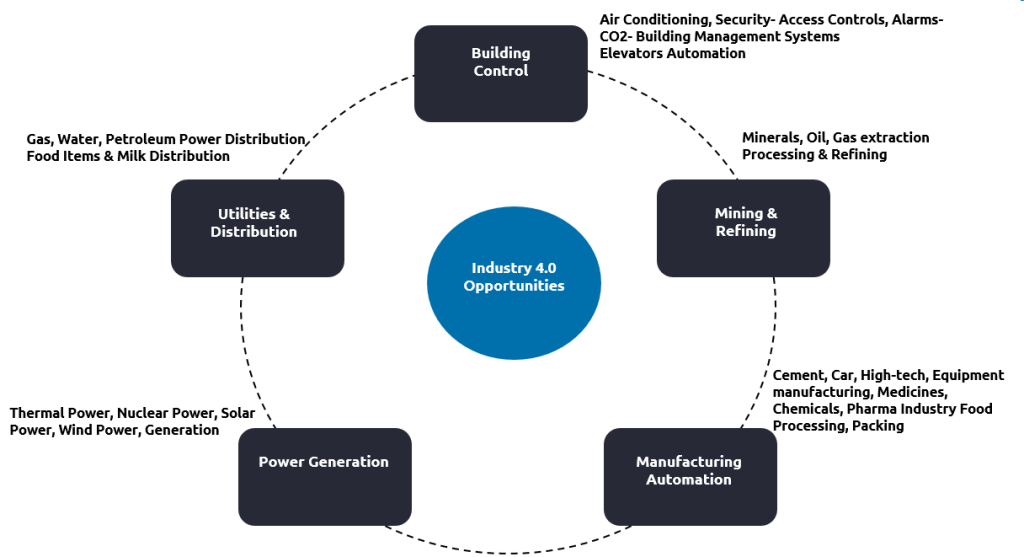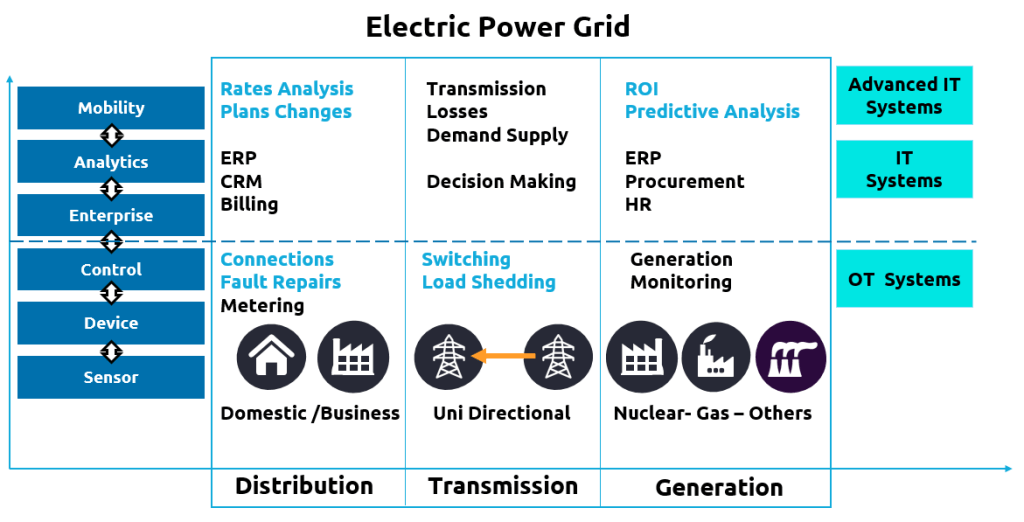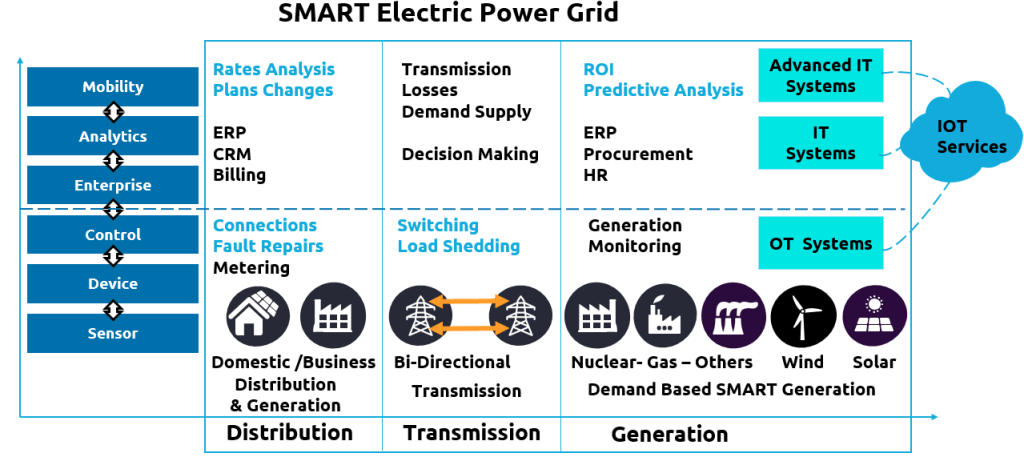Analyst predicts multi billion dollars will be invested on Industrial Internet of Things. Industrial Automation Systems getting connected to IT Systems to form IIoT. In this article let’s focus on:
- Segments which are using Industrial Automation systems
- Why these systems are getting connected
- How business will be benefited
Segment wise Industrial Automation Control systems
Industrial Automation Control Systems such as SCADA (Supervisory Control And Data Acquisition) DCS (Distributed Control System) are widely used across industries for various purposes. Industrial automation systems are end to end systems getting data from field transforming in digital format, processing it based on predefined logic. Helping industries to automate several processes, plants, industries. SCADA or DCS systems are like ERP packages having some basic functionality and can be configured as per customer needs. Simple examples like elevator controls, building security controls; complex examples such as refinery, electricity generation or distribution.
Segment wise Industrial Automation systems:

Why these systems are getting interconnected? How it will help Business?
IT OT systems are getting interconnected due to several reasons such as:
- Technical: Need to upgrade Control Systems due to OS upgrade / Aging of existing system/ Technical limitations/ absolute hardware. Upgraded systems have easy connectivity features for IT systems
- Compliance: Various Compliance requirements mandate to upgrade existing IT as well as OT systems. This lead to provide real time data to government, customers etc.
- New Services: New Services or Product need IT OT Integrations for seamless services
- Commercial: Business benefits like lesser cost, faster decision making based on real time data, just in time principle helping in reduction in inventory, increased efficiency, predictive maintenance reducing break down, analytics based monitoring helping in optimization of production as well as operations cost
How these systems are getting interconnected?
Industrial Automation Control Systems (SCADA, DCS) need to be upgraded for several technical reasons. Upgraded systems have features and capabilities to connect to IT systems. Information Technology Systems and Industrial Automation Control systems are getting interconnected with various ways like OPC, ODBC, Telematics, API etc. These Information Technology (IT) Operations Technology (OT) integrations are fast tracking IIoT deployment. Simplified diagram is given below.

IIoT deployment will happen in multiple phases. In first phase IT OT systems will be upgraded; in second phase those will be integrated; in third phase end to end process automation and simplification will be carried out. All these phases will focus on zero manual process or transactions.
Let’s understand why and IIoT systems are getting interconnected. Let’s consider modernization of Electric Power Grid. Power Grid is transforming to SMART Power Grid with IIoT
Electric Power Grids migrating to SMART Electric Power Grids:
Compliance requirements on CO2 emission; lower cost of Renewable Power generation is commercial driver. Renewable Power Generation is New Product. SMART metering initiating technical need to upgrade billing system. Overall SMART Grid need to handle real time meter data, additional renewable power generation points, bidirectional power flow, load balancing. Let’s deep drive how this is creating need to transform grid.
Electric Power Grid
Existing Power Grid functioning like Generation, Transmission & Distribution vertical. Within Generation, Transmission & Distribution IT & OT systems are working independently. Analytics on real time data may not be available in current landscape. Generation to Transmission to Distribution IT systems integration may not be there. Typical Power Grid & allied systems is shown in below diagram. Rate analysis, decisions of load shading, transmission losses identification are based on certain logic.

SMART Electric Power Grid
Increasing demand for power, increasing fossil fuel prices & compliance requirements on CO2 emission is creating turbulence in power generation. On other hand research in renewable power generation is making cost effective generation possible with Solar and Wind Power. On distribution side SMART Metering initiatives giving real time power usage and demand data. Billing systems need to be upgraded to handle SMART Meters real time data feed. Solar and Wind is dependent on weather & results in fluctuating generation. Every household can potentially generate solar or wind power. Grid need to control bi directional power flow. Grid need to regulate & step up power generation when solar power, wind power is not available. These changes creating disruption in Power Grid also creating need for SMART Power Grid.

Electricity demand is going up day by day. Electric vehicles will add power demand and multiple distribution points. Distribution vertical is transforming to Distribution & Generation. Generation transmission and distribution systems need to be integrated for seamless operations and handle fluctuations due to renewable power. Hereafter all grid operators need to enable grid for bi-directional electricity flow. They need to regulate power generation based on demand & generation. Load shading decisions will be taken up on real time data. Power trading will become popular. The way telecom billing used to have flexi rates (peak hour rates, off hours’ discounts); power market will be heading towards variable rates. Analytics will play vital role in power trading.
SCADA Systems managing Power Generation, Transmission & Distribution need to provide real time data to other subsystems. Existing CRM, billing, network management, metering systems, load shading system need to be upgraded and integrated with all other IT – OT Systems. Communication and integration of various sub systems will be key to grid Modernization. There will be stringent compliance requirements as even if one of the component fails it can bring down grid. This IIoT eco system will help SMART grid to get exact demand from consumers with SMART Meters. Based on predictive analysis SMART grid will adjust power generation there by removing fluctuations. Load shading will be minimized. Overall it will result in better efficiency, cheaper electricity, benefits to end customers and lower CO2 emission.
Conclusion:
IoT deployment in Industrial automation sector is popularly known as IIoT or Industry 4.0. Commercial, Compliance, Technical, new product requirement will force IIoT adoption. IIoT will trigger integration of IT & OT systems. It will fast track modernization of existing systems. IIoT will open up several opportunities like SMART Grid, SMART factories, SMART buildings, SMART Utilities, mining & refinery industry.
Do write me for additional details.

 English | EN
English | EN 

Pls send me this post and similar ones. I’m interested in the topic of IOT/ IIOT integration.